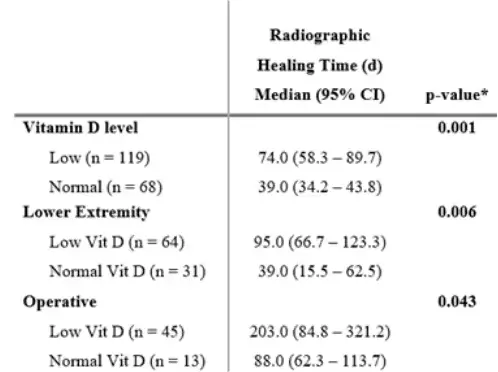Leg fractures in children requiring surgery healed months faster if high vitamin D
Low Vitamin D Levels in Pediatric Patients Linked to Slow Healing Process
Presented at American Academy of Pediatrics 2024 National Conference & Exhibition - Los Angeles
Abstract Title: Low Vitamin D Levels Are Associated with Longer Healing Times in Pediatric Fracture Patients
Catalina Baez Gainesville, FL, United States

Vitamin D plays a crucial role in bone health by aiding calcium absorption. While prior studies have explored Vitamin D's link to fracture prevention in adults, its impact on pediatric fracture healing remains underexplored. This study investigates the effect of Vitamin D levels on clinical and radiographic healing time. Secondarily, the effects of upper and lower extremity fractures, operative versus conservative management, and Vitamin D supplementation on the association between Vitamin D levels and healing time were analyzed.
A retrospective review of pediatric patients (ages 0-17) with extremity fractures and Vitamin D levels recorded within a year of injury was conducted from January 2015 to May 2022. Osteogenesis Imperfecta cases were excluded. Data were collected on demographics, medical history, injury characteristics, treatment, outcomes, Vitamin D levels, and supplementation. Vitamin D levels were defined as low (i.e., serum levels < 30 ng/ml) and normal (i.e., serum levels ≥30 ng/ml). Kaplan-Meier curves and Log-Rank tests were used for healing time and subgroup analysis.
A total of 187 fractures among 166 patients were included. Mean age was 7.9 (±5.0) years, and 62.0% (N = 103) of patients were males. Low Vitamin D levels were observed in 61.4% (n = 102) of the sample. Low Vitamin D patients had significantly longer clinical (44.0 d vs. 37.0 d, p=0.019) and radiographic (74.0 d vs. 39.0 d, p< 0.001) healing times than normal Vitamin D patients. Lower extremity fractures in low Vitamin D patients healed slower clinically (53.0 vs. 33.0 d, p=0.025) and radiographically (95.0 d vs. 39 d, p=0.006) than in normal Vitamin D patients. Similarly, surgical patients with low Vit D levels also healed slower than their normal Vitamin D counterparts clinically (83.0 vs. 50.0 d, p=0.031) and radiographically (203.0 vs. 88.0 d, p=0.043). Lack of supplementation in low Vitamin D patients was associated with longer radiographic healing times (69.0 d) than in normal Vitamin D patients (38.0 d, p=0.007).
Our findings suggest a link between low Vitamin D and slower clinical and radiographic healing in pediatric patients with lower extremity fractures and surgical management. Although the role of Vitamin D supplementation is unclear, the lack of supplementation in patients with decreased Vitamin D levels was associated with slower radiographic fracture healing. As such, surgeons should consider evaluating Vitamin D levels in pediatric fracture patients and advise on the potential for slower bone healing when these levels are below 30ng/ml.
VitaminDWiki - studies in both categories Falls/Fractures and Infant/Children
This list is automatically updated
{category}
